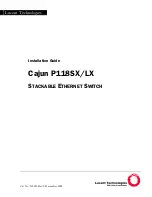
1-6
Unsolicited triggering of a client
A client initiates authentication by sending an EAPOL-Start packet to the device. The destination
address of the packet is 01-80-C2-00-00-03, the multicast address specified by the IEEE 802.1X
protocol.
Some devices in the network may not support multicast packets with the above destination address,
causing the authentication device unable to receive the authentication request of the client. To solve the
problem, the device also supports EAPOL-Start packets whose destination address is a broadcast MAC
address. In this case, the iNode 802.1X client is required.
Unsolicited triggering of the device
The device can trigger authentication for clients that cannot send EAPOL-Start packets and therefore
cannot trigger authentication, for example, the 802.1X client provided by Windows XP. Based on the
differences in packet transmission mode, unsolicited triggering of the device falls into two categories:
z
Multicast triggering mode: The device multicasts EAP-Request/Identify packets periodically (every
30 seconds by default) to clients.
z
Unicast triggering mode: The device deems that a new user is attached to itself upon receiving a
data frame on a port with the source MAC address not included in the MAC address table. In this
case, the device sends a unicast packet out the port to trigger 802.1X authentication.
Authentication Process of 802.1X
An 802.1X device communicates with a remotely located RADIUS server in two modes: EAP relay and
EAP termination. The following description takes the EAP relay as an example to show the 802.1X
authentication process.
EAP relay
EAP relay is defined in IEEE 802.1X. In this mode, EAP packets are carried in an upper layer protocol,
such as RADIUS, so that they can go through complex networks and reach the authentication server.
Generally, relaying EAP requires that the RADIUS server support the EAP attributes of EAP-Message
and Message-Authenticator, which are used to encapsulate EAP packets and protect RADIUS packets
carrying the EAP-Message attribute respectively.
Figure 1-8
shows the EAP packet exchange procedure with EAP-MD5.
Содержание S7902E
Страница 82: ...1 4 DeviceA interface tunnel 1 DeviceA Tunnel1 service loopback group 1 ...
Страница 200: ...1 11 DeviceB display vlan dynamic No dynamic vlans exist ...
Страница 494: ...ii Displaying and Maintaining Tunneling Configuration 1 45 Troubleshooting Tunneling Configuration 1 45 ...
Страница 598: ...ii ...
Страница 1757: ...4 9 ...
Страница 1770: ...6 4 ...
Страница 2017: ...2 11 Figure 2 3 SFTP client interface ...
Страница 2062: ...i Table of Contents 1 URPF Configuration 1 1 URPF Overview 1 1 What is URPF 1 1 How URPF Works 1 1 Configuring URPF 1 2 ...
Страница 2238: ...1 16 DeviceA cfd linktrace service instance 1 mep 1001 target mep 4002 ...
Страница 2442: ...2 4 Set the interval for sending Syslog or trap messages to 20 seconds Device mac address information interval 20 ...
















































